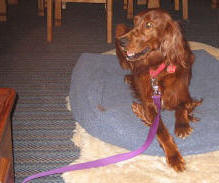Teach your dog calm,
acceptable indoor
manners
A
close tether is a 4-6 foot lead.
The idea
is to teach your dog to enjoy
being confined for short
periods of time. You are
communicating to the dog, "When tethered,
you are safe and pleasing me."
 TIP:
Do not begin close
tether training until a
puppy is leash trained
after 10 - 12 weeks of
age.
TIP:
Do not begin close
tether training until a
puppy is leash trained
after 10 - 12 weeks of
age.
It is detrimental to the dog to
be tethered alone
for long periods of time.
Close tethering means you are
close by in the same room.
Adapting your dog
to a tether will actually
increase his freedom. He will
be able to go more places with
you if you can "park"
him in a close tether knowing he
is content and will not create
a problem.
|
You want the dog to
understand close tethering
is an
opportunity to nap, relax or enjoy a favorite "chew" -
and please you, too. |
The short length of the leash
helps prevent the dog from
becoming tangled in the leash.
The ideal tether is a short lead
with a strong snap on each end.
he snaps enable you to quickly
attach the tether from the
collar to any solid object. An
alternative is to use the loop
to thread the leash hook around
a heavy object then back to your
dog's collar. If your dog is a
"chewer", consider a
light-weight metal link chain
lead or spray
a taste deterrant on the lead.

Tether
your dog when he can be close to
you for an hour or so. Tether
the dog to your chair while
reading, watching TV, or working
at your desk. Take him out to
eliminate and give access to
water before tethering. When he whimpers
or fusses, ignore or take out
to eliminate (e.g. during
housetraining), but be robotic
not attentive when he is outside
to do his business.
|
If you are confident he does
not need to eliminate,
literally turn your back on
fussing, then praise "quiet
inactivity." |
Reasons for
close tethering:
-
Bonding:
An excellent bonding
exercise for the independent
dog is to have the dog next
to you every minute possible
when you are home. If no other
place is available, tie him
to your belt or ankle which
is called, "Umbilical
Cording."
minute possible
when you are home. If no other
place is available, tie him
to your belt or ankle which
is called, "Umbilical
Cording."
-
Fearfulness
- Close tether training gives
the fearful dog the security
of knowing where he belongs,
and how to act when taken
to a new environment.
-
Housebreaking
- Dogs do not like to eliminate
in their immediate area. Take
the dog out regularly, and
praise appropriate elimination.
If elimination does not occur,
return to tethering, and praise
quiet inactivity.
-
Calming
– Tethering calms the
hyperactive dog inside the
car or house, especially when
you have guests.
-
Separation
Anxiety - Once calm,
gradually leave dog tethered for
an increasing number of minutes, while
staying under the threshold
where anxious signs begin.
Then, gradually tether further
away from you. Ignore the dog when leaving
and returning. This is part
of the "Independence
Training" process.
|
A
relaxed dog can be tethered
with supervision for hours. |
-
Destructive
Tendencies - Close
tethering prevents the dog
from destroying possessions.
Provide a "chew puzzle"
while tethered as an alternative
energy outlet. A chew puzzle
is a chew toy with food inside.
If separation anxiety is the
cause, begin "Independence
Training" described above.
-
Chew
Training –
While tethered near you, provide
an approved chew toy, one at
a time. Leave each toy until
it becomes boring. Praise
any interest. Kongs with a
light layer of peanut butter
often help get the dog
started. .
-
Status
- If the dog acts aggressive,
give him a "Time Out"
tethered near you for 5-10
minutes. Tethering reduces
hierarchical status.
-
Socialization
- The tether can be used as
part of a socialization program
by allowing the dog to see
and be a part of people's
activities without being the
center of attention.
 A
dog who can be tethered without
fussing, possesses a skill that
will be handy in many situations
in life. Remember, his
greatest joy is to be near you and please you.
A
dog who can be tethered without
fussing, possesses a skill that
will be handy in many situations
in life. Remember, his
greatest joy is to be near you and please you.